Cone Beam Computed Tomography (CBCT) has become a cornerstone of modern dental diagnostics, offering high-resolution, 3D imaging that enables more accurate assessment of teeth, bone structures, and pathology. For DSOs and dentists managing increasingly complex cases, CBCT unlocks powerful insights—but it also introduces new challenges in interpretation, workflow efficiency, and standardization across providers.
That’s where artificial intelligence (AI) is making a significant impact. Overjet’s dental AI platform enhances CBCT imaging by delivering real-time, data-driven analysis that helps clinicians detect conditions earlier, plan treatments more precisely, and ensure consistent care across locations.
By turning dense image data into actionable insights, AI empowers dental organizations to improve clinical accuracy, streamline documentation, and scale quality across growing provider networks. Whether you're operating a single practice or a multi-site DSO, integrating AI into your CBCT workflow offers a smarter, faster path to better outcomes and operational excellence.
Explore Overjet's AI Dental Imaging
1. What Is CBCT Imaging?
Cone Beam Computed Tomography (CBCT) is an advanced dental imaging technology that captures high-resolution, 3D images of a patient’s oral and maxillofacial anatomy in a single scan. Unlike traditional 2D dental X-rays, CBCT delivers volumetric data—allowing dentists to view structures from multiple angles with exceptional clarity.
This enhanced visibility helps dental professionals diagnose, plan, and treat with greater accuracy. From bone density and nerve pathways to soft tissue and root morphology, CBCT provides critical anatomical details that support more confident decision-making.
CBCT is commonly used in a wide range of dental and surgical applications, including:
Implant Planning: Evaluate bone volume, angulation, and proximity to vital structures for precise implant placement.
Orthodontic Assessment: Analyze tooth position and jaw relationships to support effective treatment planning.
Endodontic Diagnosis: Identify complex root canal systems, fractures, or lesions that are often missed on standard radiographs.
TMJ Evaluation: Assess temporomandibular joint anatomy and dysfunction in detail.
Oral Pathology Detection: Detect cysts, tumors, or abnormal growths at an earlier stage.
As more dental practices and DSOs adopt CBCT systems, the demand for efficient, accurate image interpretation is also growing. That’s where artificial intelligence (AI) plays a pivotal role—transforming raw data into actionable insights to enhance patient care, streamline workflows, and support scalable growth.
2. Clinical Benefits of CBCT in Dentistry
Cone Beam Computed Tomography (CBCT) has become a cornerstone of modern dental diagnostics, offering a level of anatomical detail and accuracy that 2D imaging simply cannot match. Its ability to capture 3D, high-resolution views of oral and maxillofacial structures enhances clinical confidence and patient care across specialties.
Key clinical benefits of CBCT include:
Superior Visualization of Anatomical Structures: Clinicians gain a clear view of critical areas such as the mandibular canal, maxillary sinus, and adjacent nerve pathways—essential for avoiding complications during surgical procedures.
Precise Bone Quality and Volume Assessments: CBCT allows for detailed evaluation of bone density and volume, enabling more predictable implant placement and grafting decisions.
Improved Surgical and Implant Planning: With 3D models, practitioners can plan surgeries with pinpoint accuracy, reducing chair time, surgical risk, and the need for intraoperative adjustments.
Enhanced Endodontic Diagnosis: CBCT reveals complex root canal anatomy, vertical root fractures, and periapical lesions that often go undetected on standard radiographs.
These diagnostic advantages translate into:
More accurate treatment plans
Reduced clinical guesswork
Faster, more confident decision-making
Improved patient communication and outcomes
For DSOs and high-volume practices, CBCT ensures consistency in care delivery across providers and locations—especially when paired with AI tools like Overjet that interpret radiographs with real-time, data-backed precision.
3. Challenges of Interpreting CBCT Scans
While CBCT technology offers remarkable diagnostic potential, interpreting the large volumes of data it produces can be a significant challenge—especially in fast-paced dental practices or large provider networks.
Some of the most common challenges include:
High Data Volume: A single CBCT scan can generate hundreds of image slices, requiring careful, time-consuming review. For busy clinicians, this can lead to diagnostic fatigue or rushed analysis.
Variability Across Providers: Interpretation accuracy often depends on the provider’s training and experience. This variability can lead to inconsistent diagnoses, affecting treatment decisions and patient outcomes.
Risk of Missed Pathologies: Small or subtle findings—such as apical lesions, resorptive defects, or anatomical anomalies—can be overlooked during manual review, especially when time is limited.
Manual Documentation Errors: Recording findings from CBCT scans typically involves manual input, which increases the risk of omissions or inconsistencies. This not only affects patient records but can complicate insurance claims or audit readiness.
For DSOs and multi-provider practices, these challenges are amplified. Ensuring consistent, high-quality CBCT interpretation across multiple locations becomes a logistical and clinical concern.
This is where AI-powered tools like Overjet add value. By automating parts of the diagnostic review and highlighting key findings in real time, Overjet helps dental teams manage CBCT data more efficiently—reducing diagnostic variability, saving time, and supporting more informed clinical decisions.
4. How AI Improves CBCT Interpretation
As CBCT imaging becomes more common in dental practices, the ability to interpret these scans efficiently and accurately is more critical than ever. That’s where artificial intelligence (AI)—specifically Overjet’s advanced dental AI platform—adds powerful value.
Overjet uses machine learning models trained on millions of annotated images to assist clinicians in interpreting CBCT data with speed and precision. When integrated into your workflow, AI can:
Automatically Detect Clinical Conditions: Overjet identifies signs of bone loss, caries, apical lesions, and other pathologies that might be missed during manual review.
Highlight Key Anatomical Landmarks: Structures such as the mandibular canal, sinus floor, and nerve pathways are clearly visualized and annotated, reducing risk during treatment planning.
Apply Visual Overlays: Findings are displayed with color-coded, easy-to-read overlays directly on the 3D scan, helping both clinicians and patients better understand the results.
Standardize Diagnostics Across Providers: Whether you’re managing a single practice or a multi-location DSO, AI ensures consistent diagnostic standards—minimizing variability and supporting better outcomes.
By turning large volumes of complex scan data into streamlined, actionable insights, Overjet enhances both clinical efficiency and diagnostic accuracy. Providers can make informed treatment decisions faster, and patients gain clarity through visual explanations that increase trust and case acceptance.
In short, AI doesn’t replace the expertise of the clinician—it amplifies it, turning CBCT imaging into a smarter, more scalable tool for dental care.
5. Why Overjet Is the Leading AI Platform for CBCT Enhancement
When it comes to maximizing the value of CBCT imaging, Overjet stands apart as the industry’s most advanced and trusted AI solution. As the first and only dental AI platform FDA-cleared for both caries detection and bone level measurement, Overjet brings a new level of clinical intelligence to radiographic interpretation—including 3D CBCT scans.
Overjet’s AI integrates directly into your existing imaging and practice management systems, allowing for seamless deployment without disrupting clinical workflows. It transforms complex imaging data into actionable insights that support better, faster decision-making—whether during implant planning, endodontic assessments, or oral surgery evaluations.
Key Advantages of Overjet for CBCT Imaging:
Real-Time Analysis: Overjet overlays diagnostic insights and measurements directly onto CBCT scans, helping clinicians identify bone loss, decay, and anatomical structures at a glance.
Broad Compatibility: The platform works with major PACS and imaging software, ensuring smooth integration regardless of your current tech stack.
Clinical and Business Dashboards: Overjet’s analytics tools allow you to track diagnostic consistency, provider performance, and case acceptance metrics across single or multi-site operations.
Trusted Nationwide: Overjet is already used by top dental service organizations (DSOs), private equity-backed practices, and leading dental schools to enhance care quality and efficiency.
By streamlining CBCT interpretation and delivering clinical clarity at scale, Overjet helps dental organizations elevate both patient care and operational performance—all while preparing for the future of data-driven dentistry.
6. Clinical and Operational Advantages of AI-Enhanced CBCT
Integrating artificial intelligence into CBCT imaging transforms it from a powerful diagnostic tool into a true driver of clinical and operational excellence. AI-enhanced CBCT, especially when powered by Overjet, adds real-time intelligence to radiographic interpretation—helping dental teams work smarter, faster, and more consistently.
From a clinical standpoint, AI eliminates guesswork by instantly analyzing complex 3D datasets and highlighting areas of concern such as bone loss, pathology, or anatomical anomalies. This allows providers to make more confident diagnoses and develop treatment plans with greater accuracy. AI also enables earlier detection of issues that may otherwise be missed during manual review, supporting a more preventive and proactive approach to care.
On the operational side, AI streamlines documentation by generating visual annotations and quantifiable data that support insurance submissions and compliance reporting. This reduces the administrative burden on clinical teams and helps prevent denials or delays in reimbursement.
Key Benefits of AI-Enhanced CBCT Include:
Faster and more confident diagnostic decisions
Higher patient understanding through clear visual overlays
Increased case acceptance due to improved communication
Reduced diagnostic variability across providers
Better documentation for audits, pre-authorizations, and claims
By improving both the quality of care and the efficiency of workflows, AI-enhanced CBCT contributes directly to stronger patient outcomes, improved team collaboration, and scalable practice growth. With Overjet, practices can truly unlock the full value of their CBCT technology.
7. Real-World Results with Overjet
Dental organizations that implement Overjet’s AI-powered technology are seeing measurable improvements across clinical, operational, and financial metrics. By enhancing diagnostic accuracy, streamlining documentation, and improving patient communication, Overjet helps practices deliver better care while driving stronger business outcomes.
One of the most impactful benefits is the increase in case acceptance.
Practices using Overjet report a 10–20% boost in accepted treatment plans, largely due to AI-generated visual overlays that help patients better understand their diagnoses. When patients can see color-coded evidence of decay or bone loss directly on their radiographs, they’re more likely to trust the provider’s recommendation and move forward with care.
Overjet also supports more accurate and consistent diagnoses across all providers—reducing clinical variability, eliminating second-guessing, and ensuring every patient receives the same high standard of care.
From an administrative perspective, Overjet improves insurance documentation with AI-annotated visuals and standardized metrics, significantly reducing the likelihood of claim denials and speeding up reimbursement cycles.
Finally, the combination of real-time diagnostics and same-day treatment planning enables practices to deliver more value per visit. This translates into higher revenue per appointment and more efficient use of chair time—essential ingredients for sustainable growth.
Whether you're a single office or a DSO with dozens of locations, Overjet delivers scalable, real-world impact where it matters most: patient outcomes, operational efficiency, and financial performance.
8. Getting Started with Overjet for CBCT
Implementing Overjet for CBCT enhancement is a seamless process designed to deliver immediate value—whether you're a solo practitioner or leading a multi-site DSO. From the moment you onboard, Overjet’s team partners with yours to ensure a smooth, successful rollout.
Here’s what to expect:
Custom Implementation Plans: Every practice has a unique CBCT setup. Overjet tailors the integration to your imaging systems and workflow to minimize disruption and maximize compatibility.
Team Training: Both clinical and administrative teams receive comprehensive training to understand how to use Overjet’s AI features in daily operations—ensuring rapid adoption and confidence at every touchpoint.
Performance Dashboards: With built-in analytics tools, you can track diagnostic accuracy, case acceptance, and documentation quality. These insights support ongoing improvements and help demonstrate ROI.
Scalable Infrastructure: Whether you're managing one office or fifty, Overjet’s enterprise-ready platform grows with you. Consistency, visibility, and standardization become achievable at scale.
By enhancing CBCT with real-time AI analysis, Overjet transforms how dental teams diagnose, communicate, and document care. With the right support and tools in place from day one, smarter imaging and more efficient workflows are not just possible—they're immediate.
Let Overjet help you unlock the full potential of your CBCT technology and elevate patient care across your entire organization.
Ready for AI to Improve You CBCT Imaging?
CBCT imaging has set a new standard for dental diagnostics, and AI is taking it even further. Overjet enhances every scan with real-time insights, helping dental professionals deliver consistent, high-quality care. In today’s fast-paced environment, combining CBCT with Overjet isn’t just a smart choice—it’s the future of dentistry.
Ready to see Overjet's Dental AI in Action?
FAQs
1. What is the difference between CBCT and traditional dental X-rays?
CBCT provides 3D volumetric images, offering more detail and diagnostic insight than 2D X-rays.
2. Is CBCT safe for routine dental use?
Yes. CBCT uses low-dose radiation and is considered safe when used appropriately.
3. Can Overjet analyze CBCT as well as traditional 2D images?
Yes. Overjet is designed to interpret both 2D radiographs and 3D CBCT images.
4. How does Overjet integrate with existing CBCT systems?
Overjet integrates with most major imaging systems and PACS for seamless workflow.
5. Who benefits most from AI-enhanced CBCT?
DSOs, group practices, and high-volume clinics looking for diagnostic consistency and efficiency gain the most from Overjet-enhanced CBCT.









